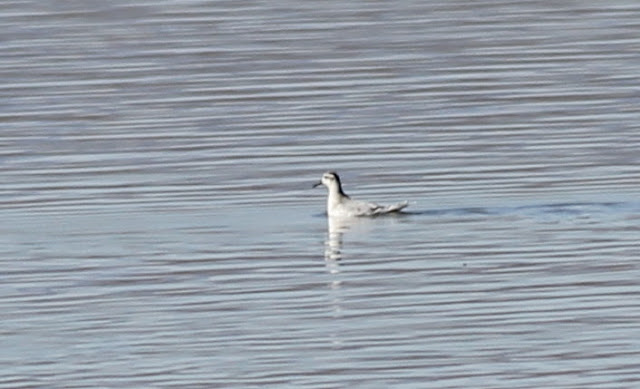31 October 2012
Balmorhea Lake, Balmorhea, Reeves Co., TX
 |
| Red Phalarope (Phaloropus fulicarius) |

** Excerpt from TX-Birds list-serve**
RED PHALAROPE pics from this morning at Balmorhea Lake.
Found initially (FOUND AND ID) by
Heidi Trudell, I like to think I was slightly distracted driving. :) http://www.bigbendnature.com/2012/10/red-rope-blam-orhea-lake-reeves-co.html This bird was first noticed on the eastern half of the lake, as we were on the east dam. Easily enjoyed through bins, a scope is great. After a lunch break in town, we re-located the bird at 1:18 PM on the western quarter of the lake. Also could be enjoyed through bins during this observation NO Surf Scoter was seen. In fact, the raft of scaup, ruddys, and redhead the scoter sought refuge in was gone as well.**Excerpt from TX-Birds facebook note originally from Heidi Trudell**
Seen from 11:20-noon at the dam, seen from 1:18-1:25 at the total opposite end of the lake (near reeds on west end) before it headed back toward the middle of the lake.
Edit:
Here's the combined morning/afternoon list from Lake Balmorhea (apologies for lack of numbers here), perks from the town and cemetery are at the bottom!
Snow Goose (Chen caerulescens)
Gadwall (Anas strepera)
Mallard (Anas platyrhynchos)
Blue-winged Teal (Anas discors)
Northern Shoveler (Anas clypeata)
Northern Pintail (Anas acuta)
Redhead (Aythya americana)
Lesser Scaup (Aythya affinis)
Red-breasted Merganser (Mergus serrator)
Ruddy Duck (Oxyura jamaicensis)
Scaled Quail (Callipepla squamata)
Common Loon (Gavia immer)
Pied-billed Grebe (Podilymbus podiceps)
Eared Grebe (Podiceps nigricollis)
Western Grebe (Aechmophorus occidentalis)
Clark's Grebe (Aechmophorus clarkii)
Double-crested Cormorant (Phalacrocorax auritus)
American White Pelican (Pelecanus erythrorhynchos)
American Bittern (Botaurus lentiginosus)
Great Blue Heron (Ardea herodias)
Snowy Egret (Egretta thula)
Cattle Egret (Bubulcus ibis)
Golden Eagle (Aquila chrysaetos)
Northern Harrier (Circus cyaneus)
American Coot (Fulica americana)
Killdeer (Charadrius vociferus)
American Avocet (Recurvirostra americana)
Spotted Sandpiper (Actitis macularius)
Least Sandpiper (Calidris minutilla)
Red Phalarope (Phalaropus fulicarius)
Bonaparte's Gull (Chroicocephalus philadelphia)
Franklin's Gull (Leucophaeus pipixcan)
Ring-billed Gull (Larus delawarensis)
Herring Gull (Larus argentatus)
Eurasian Collared-Dove (Streptopelia decaocto)
Mourning Dove (Zenaida macroura)
Greater Roadrunner (Geococcyx californianus)
Belted Kingfisher (Megaceryle alcyon)
Northern Flicker (Colaptes auratus)
Say's Phoebe (Sayornis saya)
Vermilion Flycatcher (Pyrocephalus rubinus)
Common Raven (Corvus corax)
Verdin (Auriparus flaviceps)
Rock Wren (Salpinctes obsoletus)
Winter Wren (Troglodytes hiemalis)
Marsh Wren (Cistothorus palustris)
Blue-gray Gnatcatcher (Polioptila caerulea)
Black-tailed Gnatcatcher (Polioptila melanura)
Golden-crowned Kinglet (Regulus satrapa)
Ruby-crowned Kinglet (Regulus calendula)
Northern Mockingbird (Mimus polyglottos)
American Pipit (Anthus rubescens)
Yellow-rumped Warbler (Setophaga coronata)
Green-tailed Towhee (Pipilo chlorurus)
Spotted Towhee (Pipilo maculatus)
Vesper Sparrow (Pooecetes gramineus)
Lark Bunting (Calamospiza melanocorys)
Savannah Sparrow (Passerculus sandwichensis)
Song Sparrow (Melospiza melodia)
Lincoln's Sparrow (Melospiza lincolnii)
Swamp Sparrow (Melospiza georgiana)
White-crowned Sparrow (Zonotrichia leucophrys)
Pyrrhuloxia (Cardinalis sinuatus)
Red-winged Blackbird (Agelaius phoeniceus)
Yellow-headed Blackbird (Xanthocephalus xanthocephalus)
Great-tailed Grackle (Quiscalus mexicanus)
House Sparrow (Passer domesticus)
***
Town highlight:
Western Scrub-Jay (Aphelocoma californica) - heard only
Cemetery, complete list:
Greater Roadrunner (Geococcyx californianus)
American Kestrel (Falco sparverius)
Common Raven (Corvus corax)
Bewick's Wren (Thryomanes bewickii)
Northern Mockingbird (Mimus polyglottos)
Curve-billed Thrasher (Toxostoma curvirostre)
Vesper Sparrow (Pooecetes gramineus)
Black-throated Sparrow (Amphispiza bilineata)
Sage Sparrow (Artemisiospiza belli)


































